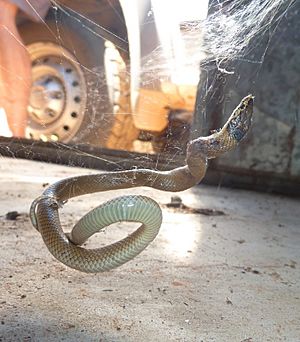Curl snake facts for kids
Quick facts for kids Curl snake |
|
|---|---|
 |
|
| Conservation status | |
| Scientific classification | |
| Genus: |
Suta
|
| Species: |
suta
|
 |
|
| Image depicting the range of the curl snake | |
| Synonyms | |
|
|
The curl snake (Suta suta) is a type of venomous snake that lives in Australia. It belongs to the Elapidae family, which includes many venomous snakes. In Western Australia, it is also known as the myall snake. People sometimes confuse it with the Ord curl snake (Suta ordensis), which looks similar.
Contents
What Does the Curl Snake Look Like?
Curl snakes are usually about 40 cm (16 in) long. Some can grow to 60 cm (24 in) or even longer! They have a wide head and a strong body. Their color is usually dark brown or reddish brown.
Special Features
Their head is often darker than their body. The underside of their body is usually paler. A cool thing about them is their light-colored eyes and small pupils. They also have a dark stripe, often orange, that goes from each eye to their snout. Sometimes, the scales on their back have darker edges. This makes them look like they are "stitched" together, which is where their scientific name suta comes from.
Where Do Curl Snakes Live?
You can find curl snakes in almost all parts of Australia, except for Tasmania. They mostly live in dry areas in eastern and central Australia. In Victoria, they are only found in the northern and central parts. In Western Australia, they stick to the far northeastern areas.
Their Home Environment
Curl snakes like to live in grasslands, scrublands, and open woodlands. They are active at night, searching for food among fallen leaves and under rocks. During the day, they hide in old burrows, cracks in the soil, under wood, or in leaf litter.
Conservation Status
Most places consider the curl snake's population to be safe. However, in Victoria, it is considered a vulnerable species. This is because there is less ground cover for them to hide in.
What Do Curl Snakes Eat?
Curl snakes mainly eat other small reptiles, like geckos, skinks, legless lizards, and even other snakes. They also eat small mammals and frogs sometimes. Mammals can make up about 20% of their diet.
How Do Curl Snakes Have Babies?
Curl snakes are special because they give birth to live young. This is called viviparous. Most snakes lay eggs, which is called oviparous. A mother curl snake usually has about five babies at a time. They can have anywhere from one to seven babies. When they are born, the baby snakes are about 15 cm (6 in) long.
How Do Curl Snakes Behave?
The curl snake gets its name from how it defends itself. When it feels threatened, it curls up tightly into a spring-like coil. This protects its head. After coiling up, it might thrash around violently to scare away danger.
Are Curl Snakes Dangerous?
Yes, the curl snake's venom is dangerous. It is a neurotoxic venom, which means it affects the nervous system. Bites from larger curl snakes are especially dangerous. If someone is bitten, they should get medical help right away. It's important to keep the person still and apply a pressure bandage to the bite area.


